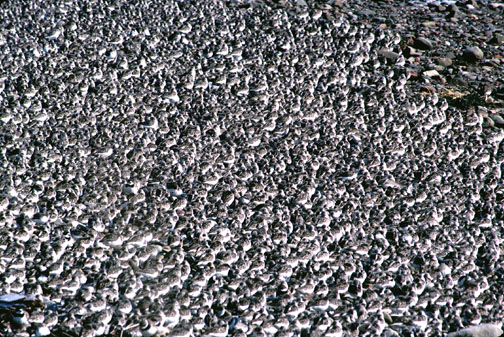|
Global warming is already having a profound impact on ecosystems around the globe, and promises to have a greater and greater impact as the mercury slowly climbs. However, large events always have more importance to us when they touch our own lives. This past summer global warming touched mine.
The Semipalmated Sandpiper (named for the partial webbing between its toes), the most common sandpiper seen in eastern North America, is a small shorebird that breeds in the North American Arctic tundra and winters along the coast of northern South America. In late spring and again in late summer it passes along our shores during its semiannual migrations. Plumaged in muted shades of brown, buff, gray and white, its beauty is subtle and best appreciated at close range. However, the bird's noteworthiness comes not from its looks but from its lifestyle. The fact that a bird weighing only 20-30 grams (0.7-1.05 ounces) makes an annual trip from the Arctic to South America and back to the Arctic again is reason enough for awe, but the manner in which it makes that journey is even more amazing. After their very brief nesting season, when it comes time for Semipalmated Sandpipers to head south in July, a large percentage of the birds fly nonstop from their breeding grounds in the low Arctic to the extensive mudflats of the upper Bay of Fundy in New Brunswick and Nova Scotia. Here they stop to replenish the fat reserves they use as fuel during migration Then comes the amazing part. After 10-20 days of feverish feeding in the Bay of Fundy staging area, and approximately doubling their weight, these tiny little birds fly nonstop for three days to Suriname and French Guiana on the northeast coast of South AmericaNONSTOP FOR THREE DAYS! Try flapping your arms up and down fast for just three minutes, and then think about what it would be like to have to do it for three days, and then imagine that your life depends on it. Lee Calkins describes it best in The Sandpipers of Fundy, ".growing increasingly restless as the time to fly draws closer. When the arrival of a cold front brings strong tail-winds, they orient themselves south-southeast in huge flocks, finally taking wing when a high tide coincides with the end of the day. Their flight pattern takes them well out to sea over the North Atlantic where they catch the trade winds that carry them to landfall on the northern coast of South America." During the voyage they will burn off all their recently accumulated fat as well as a percentage of their muscle mass, and those that make it (not all do) will arrive exhausted on the coastal mudflats of the Guianas. I get goosebumps every time I think about it.
I became intimately familiar with Semipalmated Sandpipers 30 years ago when I worked for several seasons on a shorebird migration project at Manomet Bird Observatory, along the Massachusetts shore near the base of Cape Cod. Our work involved censusing beaches along the Massachusetts coast for migrating shorebirds as well as capturing the birds so that we could affix numbered aluminum bands to their legs. During the day we would be out on the beaches, mudflats and saltmarshes from Newburyport to Eastham, censusing shorebirds as they fed and roosted. Then at night we would set up our nets along the tide line at Plymouth Beach to capture shorebirds for banding. Throughout the study, the commonest species was Semipalmated Sandpiper. The daytime censuses would frequently turn up 10,000 to 20,000 of them, and during our nocturnal banding sessions we would frequently handle 300 or so. In the course of my time with the project I handled many thousands of the beautiful little birds, banding them, then measuring the length of their bills, wings and legs, checking their fat condition and state of molt, and weighing them before releasing them again to the tidal flats. Since leaving Manomet Bird Observatory I have maintained my connection with these little birds I have come to know so well. I have been fortunate enough to spend considerable time in South America, where I've encountered Semipalmated Sandpipers along the Suriname coast. Sitting in the heat, humidity and mosquitoes, I observed the familiar birds feeding in an unfamiliar habitat. Vast amounts of sediment carried west from the mouth of the Amazon River have created rich mudflats among the mangroves - an ideal winter home for the species. As a bird artist, shorebirds are my favorite group of birds and as I know Semipalmated Sandpipers so well, they have been frequent painting subjects. More recently I have been spending late July and early August along the shores of the upper Bay of Fundy in New Brunswick, assisting Canadian Wildlife Service researchers in a long-term banding study of the sandpipers. For the last 20 years or so, Canadian Wildlife Service biologist Peter Hicklin has been studying Semipalmated Sandpipers during their late summer stopover in the upper Bay of Fundy. It turns out that this area is an extremely crucial link in the annual cycle of the species. In fact, up to 95 % of the world population of the species depends on the mudflats of the Bay of Fundy for their survival. At the peak of their migration through the area the mudflats support one to two million of the small sandpipers. There is probably no other area on the east coast of North America capable of sustaining such vast numbers of Semipalmated Sandpipers during this critical period in their cycle. The key to the area's importance to the sandpipers lies in tiny mud-dwelling invertebrates known as mud shrimp, (Corophium volutator in scientific terms), the primary food of the birds during their stopover. The Corophium are found in the mud at the incredible density of 10,000 to 60,000 per square meter, providing an abundant food source for the hungrily feeding sandpipers.
But all is not well. Over the course of Hicklin's study, the number of Semipalmated Sandpipers using the Fundy mudflats has been decreasing. At first it was thought that the problem might lie with a diminishing food supply in the area, but that theory did not seem to fit well. Besides, the decline was more complicated than that. There are two populations of Semipalmated Sandpipers that use the Fundy mudflats during their southward migration, a short-billed population from the western Canada Arctic and Alaska, and a long-billed population from the eastern Canadian Arctic. On the Fundy mudflats it has been the long-billed eastern birds that have been disappearing, a conundrum that has confounded Hicklin. And then the answer finally came via a colleague who works near James Bay, at the southern end of Hudson Bay, in the nesting range of the eastern birds. Twenty years ago a two kilometer by two kilometer study plot in this area held about 160 nesting pairs of Semipalmated Sandpipers. Over the past twenty years this number has been steadily dropping, and for the last several years it has dropped down to just a few pairs. This past summer the number of nesting pairs dropped to zero. The reason for the decline seems clear. Twenty years ago the habitat in the study plot was a low, dense carpet of lichens and mosses, a perfect nesting substrate for the ground-nesting sandpipers. But over the past two decades, due to the steady warming of the climate, the area has been invaded by tall grasses and low shrubs from the south and has become completely unsuitable for the birds. No suitable nesting habitat means no nesting - it's that simple. As much as it pains me, the sandpipers I have come to know so well have become one more victim of global warming.
Further reading:
For more information: Climate Change Fight Moves to Domestic Legislation by John Demos HotEarth.net - http://environet.policy.net/warming/ - A source for information on global warming and how you can help prevent it. Greenpeace USA - http://www.greenpeaceusa.org/climate/ Climate Ark - Climate Change Portal - http://www.climateark.org/ - The Climate Ark is a Climate Change Portal and Internet Search Tool that provides access to reviewed climate change and alternative energy news and information. Climate Solutions (formerly Atmosphere Alliance) - http://www.climatesolutions.org/ - Climate Solutions works to effectively communicate the urgent need for action on global warming and promotes the rapid acceleration of clean energy technologies and more livable development of our communities. |
 A young Semipalmated Sandpiper feeds on the South Lubec mudflats.
Painting by Paul Donahue.
A young Semipalmated Sandpiper feeds on the South Lubec mudflats.
Painting by Paul Donahue. An adult Semipalmated Sandpiper in the upper Bay of Fundy. Photo by Paul Donahue.
An adult Semipalmated Sandpiper in the upper Bay of Fundy. Photo by Paul Donahue. A roosting flock of many thousands of Semipalmated Sandpipers on the shore of Dorchester
Cape in the upper Bay of Fundy. How much longer will this be a common sight?
Photo by Paul Donahue.
A roosting flock of many thousands of Semipalmated Sandpipers on the shore of Dorchester
Cape in the upper Bay of Fundy. How much longer will this be a common sight?
Photo by Paul Donahue. It
doesn't take much foresight to envision the grasses and shrubs
marching steadily northward as climate change progresses, eventually
claiming all of the nesting habitat of the Semipalmated Sandpipers
as well as the nesting areas of all of the other ground-nesting
birds that share the sandpipers preferred habitatLeast Sandpipers,
Hudsonian Godwits, Short-billed Dowitchers, Red-necked Phalaropes,
Lapland Longspurs, and so on. How much loss are we willing to
accept before we do something meaningful to stem the warming?
How many species are we willing to sacrifice to our extravagant
use of fossil fuels? How many people will have to feel a personal
loss before they are motivated to act? How will global warming
touch your life?
It
doesn't take much foresight to envision the grasses and shrubs
marching steadily northward as climate change progresses, eventually
claiming all of the nesting habitat of the Semipalmated Sandpipers
as well as the nesting areas of all of the other ground-nesting
birds that share the sandpipers preferred habitatLeast Sandpipers,
Hudsonian Godwits, Short-billed Dowitchers, Red-necked Phalaropes,
Lapland Longspurs, and so on. How much loss are we willing to
accept before we do something meaningful to stem the warming?
How many species are we willing to sacrifice to our extravagant
use of fossil fuels? How many people will have to feel a personal
loss before they are motivated to act? How will global warming
touch your life?